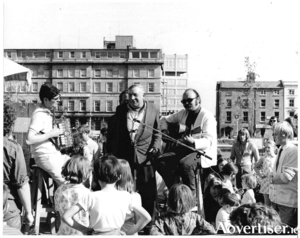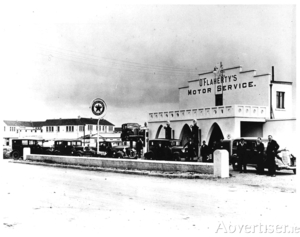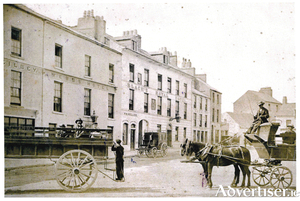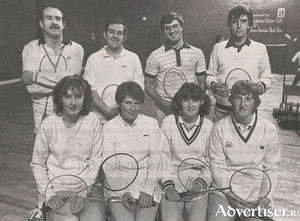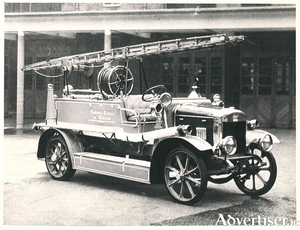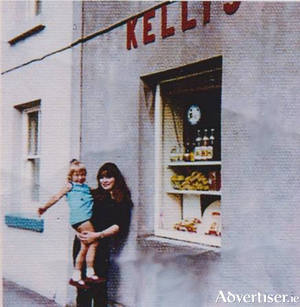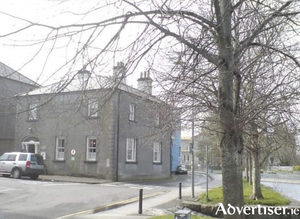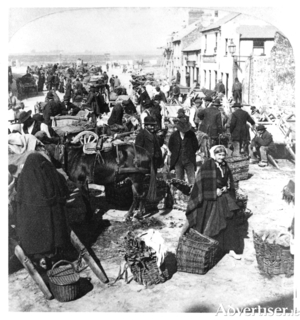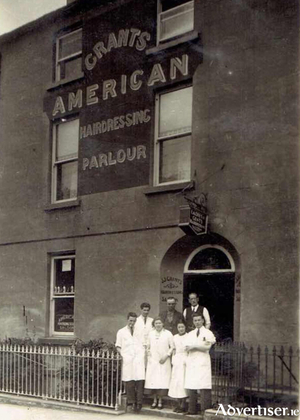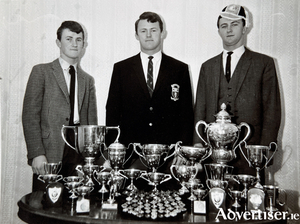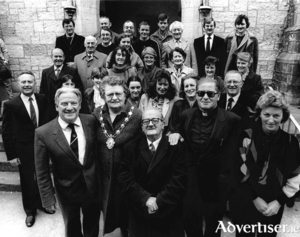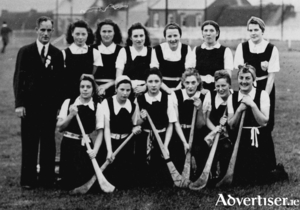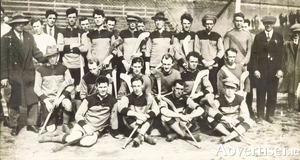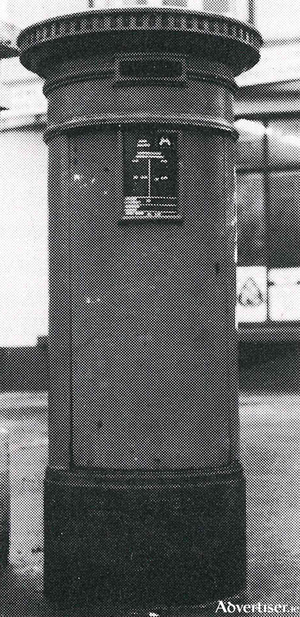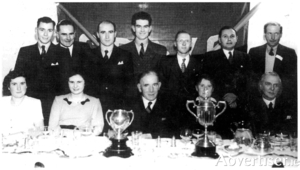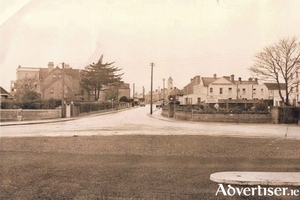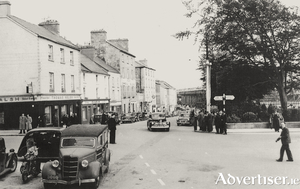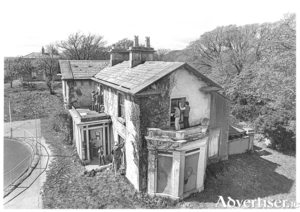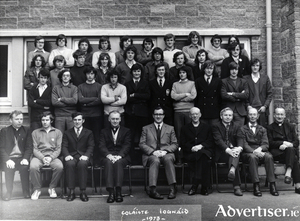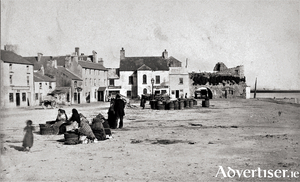Walkin’, talkin’ and touchin’
Thu, Feb 01, 2024
‘Mate’ Lydon was a Galway original, a character, a champion salmon snatcher and a great judge of porter. He was born in Rope Walk in the Claddagh in 1908. His name was Martin Lydon, but because he spent much of his childhood in his grandmother’s house, he was known locally as Máirtín Harte. He attended the Claddagh National School. He loved hurling, became a very good soccer player and was a regular on the famous Claddonians team which won the first ever Schweppes Cup in 1937. Our first image shows that team: seated Joe Flaherty, Jack O’Donnell, Martin Lydon, Bob Cantwell, Gus Flaherty, Thomas Lydon. Standing are Jimmy Connell, Martin Connell, Paddy Cubbard, Dick Ebbs, Jack Connor, Frank Fitzgerald and Eddie Cloherty. Mate usually played full back, and opposing forwards often found they had to take ‘the long way round’ to the Claddonians goal.
Read more ...O’Flaherty’s Garage
Thu, Jan 25, 2024
Patrick O’Flaherty bought an old thatch cottage in 1901 and converted it into a two-storey house which would become Numbers 15 and 16 Upper Dominick Street, part of which became a small shop operated by his wife Aggie (née Staunton) and part became O’Flaherty’s Garage. They operated a hackney service and advertised “Galway’s leading hire service in luxurious charabancs and motors (touring and saloon). All tours through beautiful Conemara radiate regularly from O’Flaherty’s”.
Read more ...Bianconi in Galway
Thu, Jan 18, 2024
Charles Bianconi is generally regarded as the man who put Ireland on wheels. He developed a network of horse-drawn carriages that became Ireland’s first integrated transport system, building on the existing mail roads and coach roads that were already there. There was a general tax on coaches at the time, which precluded the middle classes from using theirs, and a relatively peaceful period after the Battle of Waterloo meant that a great many horses, bred for the army, became cheap on the market. His system offered connections with various termini, his prices were cheap and so he was well patronised, in spite of the discomfort felt by passengers. Often, when going up a hill, some passengers would alight to make the carriage lighter for the horses.
Read more ...Peadar O’Dowd, the passing of an old Galwegian
Thu, Jan 11, 2024
Peadar O’Dowd’s credentials for writing about Galway were impeccable. One of four children, Nono, Willie, Martin and Peadar, born to their parents John and Bridget, he grew up in Bohermore and was always grateful for the fact. He lived his life there and throughout that life would celebrate the area and its people in hundreds of articles and interviews he published in various newspapers and journals.
Read more ...The Merryweather
Thu, Jan 04, 2024
Moses Merryweather and his son Richard lived in Clapham, London and they worked with the engineer Edward Field on putting his design of a vertical boiler onto a horse-drawn platform.
Read more ...The little shops of Bohermore
Thu, Dec 28, 2023
There were a few little shops at the top of Prospect Hill leading up to Bohermore — Kelly’s shop was where you got the thickest penny ice cream between two wafers. There was McInerey’s, Mary Kate Mahon’s and Lohan’s chemist. Almost next door was Tom Duffy, the tailor. On the other corner of Biddy’s Lane was Molloy’s little shop — neat as a pin.
Read more ...The homes of Woodquay
Thu, Dec 21, 2023
As we pointed out last week, much of what we now know as Woodquay was under water until the funnelling of the various streams that came down from the Corrib into the river that we know today began in the mid-19th century. As part of the project, the lands of Woodquay were gradually reclaimed. The people living in the area in those early years were mostly small farmers and fishermen. Their houses were very basic, single story, and for the most part, thatched and built of crude stone. There were of course some landmark houses but things began to change generally around the turn of that century with the construction of terraces of new slated houses around the broad space of Woodquay as we know it today, mostly built by the Urban District Council.
Read more ...Market day in Woodquay
Wed, Dec 13, 2023
There were a number of aspects to the market in Woodquay in the 19th and early 20th centuries – there was a crane for weighing potatoes at the end of the park (near the toll booth) and it was there many of the farmers who carried their wares downriver used to gather to sell. Other groups would congregate here to sell scollops for thatching houses, ‘flexible sticks’ cut from hazel trees. These were very much in demand in the city area as so many houses were thatched in those days including in Woodquay. Also in that area you would find basket makers who would weave creels, ciseáins, skibs and baskets of many shapes and sizes for sale to the public.
Read more ...An American barber shop in Eyre Square
Thu, Dec 07, 2023
John Joseph Grant emigrated to Brooklyn in New York where he learnt the haircutting trade and obviously made enough money which enabled him to come home in 1912 and set up his own business here. He also picked up quite a few tips on advertising as well, as you can see from our illustration which was published c1913. In addition to being a skilled barber, he certainly was not shy about promoting his wares – his advert is full of superlatives. “I guarantee to cure dandruff – the most modern and up-to-date barber’s shop in the Provinces – shaving soap solely manufactured by J.J. Grant – you will never get bald if you use Grant’s Imperial Hair Tonic (He must have sold this product out as he himself went bald in later life).
Read more ...Larry Cheevers
Thu, Nov 30, 2023
Larry was the eldest child of Jack and Ethel Cheevers who lived on Dalysfort Road in Salthill. They were the owners of the Forster Park Hotel and the iconic Park Café which was attached to it. Larry was educated in the Jes and in Castleknock College and went on to study dentistry in UCG — you could only do first year there at the time — and later in UCD where he finished the course and qualified.
Read more ...Heavenly music in Galway
Thu, Nov 23, 2023
On November 26, 1905, the new organ in the Augustinian Church was launched at a High Mass. The organ was placed ‘in the western gallery of the church in a handsome varnished case of specially selected woods, stands 26 feet high and 25 feet wide. The front pipes, some of which are over 18 feet long, are gilt and present a superb effect. The sides of the organ are recessed to leave room for an augmented choir and for the present, the organ is blown by hand at one end of case; at a future time it is hoped to apply a hydraulic motor to do this work. There is great variety in the tones of the various stops and the general effect of all combined is truly magnificent. The entire work reflects great credit on the builders who built it at their factory in Dublin. The number of speaking pipes in the organ is close to 2,000.'
Read more ...Siobhán McKenna
Wed, Nov 15, 2023
Siobhán Giollamhuire McKenna was born on May 24, 1922, a second daughter to Eoghan McKenna and Gretta O’Reilly, Nancy being her older sister. She was educated in Belfast, in Taylor’s Hill Convent and then after a year out sick with glandular fever, as a boarder in St Louis Convent, Monaghan.
Read more ...Galway’s triumph in the 1923 final
Thu, Nov 09, 2023
This game was not actually played until September 1924 when Galway faced Limerick in a ‘dour hour’s hurling’. “Physical strength, fitness and courage were the dominating factors. The play was strenuous if fitful and an exciting period followed the interval when Limerick made determined efforts to wipe off the arrears. Galway finished with great dash and were clearly superior on the day’s form.” These were the words of PD Mehigan who reported on the game for the Irish Times.
Read more ...Galway postboxes
Thu, Nov 02, 2023
The regular use of the words “post” and “Litir” in 15th century Irish manuscripts suggests that by that time, a postal system was already in existence here. In 1657, a Bill was passed ‘for settling the postage of England, Scotland and Ireland’ which set up a Government monopoly of the service. The Galway Post Office had been established in 1653, and the network of Post Offices throughout the county gradually grew.
Read more ...Remembering Maurice Semple
Thu, Oct 26, 2023
Maurice Semple was born in 1917, a member of a family that had continuous connection with the ‘Citie of the Tribes’ for over 400 years, one of three children of Frank Semple and Elizabeth ffrench. His father worked in a clerical capacity in the courthouse, his mother was one of the ffrenchs from Claregalway. Both his brother ffrench Semple and his sister Mary predeceased him.
Read more ...The changing face of Kingshill
Thu, Oct 19, 2023
Our first photograph today (courtesy of the National Library) is a bird’s eye view that was taken in 1953 and shows the Warwick Hotel at the top of the picture. Next to it on the right was the entrance to Lenaboy Park, and beyond that you can see part of Queeney’s shop. Next door was Doorley’s private house and then Mrs Turke’s B&B called Osterley Lodge. Opposite, on the far side of the road was Billy Binn’s house and on the corner, as you can see, was a field with a lot of trees, much used as a playground by local children. This whole area was very prone to flooding and was occasionally rendered impassable, as was the case with Hurricane Debbie.
Read more ...Traffic changes in Galway
Thu, Oct 12, 2023
When the city was being constructed in medieval times, the streets and even the lanes must have appeared wide and spacious. The only kind of traffic they would have experienced then would have been pedestrian, horse or donkey and cart and maybe the odd wheelbarrow. We have two images for you today of the east side of Eyre Square the first (courtesy the National Library) dates from c1890 and shows that type of traffic; The second (courtesy Galway County Library) shows the same area with motorised traffic. Since the latter was taken, the population has grown by 6 or 7 times, and of course, the traffic volumes have increased accordingly. So the Corporation had to make occasional changes to the bye-laws in relation to traffic.
Read more ...Galway Simon — still changing lives after campaigning beginning
Thu, Oct 05, 2023
In October 1979, two psychology students, Margaret Brehony and Kathy O’Grady teamed up with a philosophy student, Conall Mac Riocard and formed a group of volunteers. They started a twice weekly soup run to people who were sleeping rough in Galway. They made the soup and sandwiches at home and then they would do the run.
Read more ...The scholars of '73
Thu, Sep 28, 2023
What memories do you have of your schooldays? Here are some reminiscences of a few old ‘Jes-mugs’.
Read more ...The Fishmarket
Thu, Sep 21, 2023
The village of Claddagh was a unique collection of thatched cottages arranged in a very random fashion, a place apart, occupied by a few thousand souls. They had their own customs, spoke mainly in Irish, intermarried, elected their own king and had a code of laws unique to the village. Virtually the entire male population was involved in fishing, but when they landed their catch, the women took over and they were the ones who went out and sold the product.
Read more ...